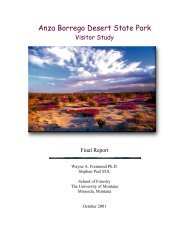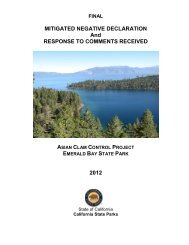Draft EIS/EIR for the San Luis Reservoir SRA Resource ...
Draft EIS/EIR for the San Luis Reservoir SRA Resource ...
Draft EIS/EIR for the San Luis Reservoir SRA Resource ...
You also want an ePaper? Increase the reach of your titles
YUMPU automatically turns print PDFs into web optimized ePapers that Google loves.
5. Environmental Analysis<br />
5.2.3 Assumptions and Methods <strong>for</strong> Evaluating Impacts<br />
Impact analyses and conclusions are based on interdisciplinary team knowledge<br />
of resources and <strong>the</strong> Plan Area, reviews of existing literature, and in<strong>for</strong>mation<br />
provided by experts in Reclamation, CSP, and o<strong>the</strong>r agencies. Impacts described<br />
in this section are based on <strong>the</strong> conceptual Plan as implemented by <strong>the</strong> proposed<br />
alternatives described in Chapter 4. The in<strong>for</strong>mation used to establish a baseline<br />
of existing conditions (including applicable laws and regulations <strong>for</strong> each<br />
resource) is described in Chapter 2. The management alternatives have been<br />
configured to optimize benefits and minimize adverse effects on both ecosystem<br />
function and <strong>the</strong> human environment. In <strong>the</strong> absence of quantitative data, best<br />
professional judgment prevails. Protocol surveys <strong>for</strong> special-status species were<br />
not conducted as part of this programmatic planning ef<strong>for</strong>t.<br />
One of <strong>the</strong> primary differences between NEPA and CEQA is <strong>the</strong> way significance<br />
is determined and discussed in environmental documents. Under NEPA,<br />
significance is used to determine whe<strong>the</strong>r an <strong>EIS</strong> or some lower level of<br />
documentation will be required. NEPA requires preparation of an <strong>EIS</strong> when <strong>the</strong><br />
proposed federal action (project) as a whole has <strong>the</strong> potential to “significantly<br />
affect <strong>the</strong> quality of <strong>the</strong> human environment.” The determination of significance is<br />
based on context and intensity (40 CFR §1508.27). Some impacts determined to<br />
be significant under CEQA may not be of sufficient magnitude to be determined<br />
significant under NEPA. Under NEPA, once a decision to prepare an <strong>EIS</strong> is made,<br />
it is <strong>the</strong> magnitude of <strong>the</strong> impact that is evaluated, and no judgment of its<br />
significance is deemed important <strong>for</strong> <strong>the</strong> text. NEPA does not require that a<br />
determination of significance <strong>for</strong> individual resources be stated in an<br />
environmental document. Once <strong>the</strong> proposal itself is considered as a whole to<br />
have significant effects, all of its specific effects on <strong>the</strong> environment (whe<strong>the</strong>r or<br />
not “significant”) must be considered, and mitigation measures must be developed<br />
where it is feasible to do so (40 CFR §1502.14(f), 1502.16(h), 1508.14, and <strong>the</strong><br />
Council on Environmental Quality’s [CEQ’s] 40 Most Asked Questions #19a 7 ).<br />
CEQA, on <strong>the</strong> o<strong>the</strong>r hand, does require an identification of each “significant effect<br />
on <strong>the</strong> environment” resulting from <strong>the</strong> project and ways to mitigate each<br />
significant effect. A significant effect on any environmental resource triggers <strong>the</strong><br />
preparation of an <strong>EIR</strong>. Each significant effect on <strong>the</strong> environment must be<br />
disclosed in <strong>the</strong> <strong>EIR</strong> and mitigated, if feasible. In addition, <strong>the</strong> CEQA Guidelines<br />
list a number of mandatory findings of significance that also require <strong>the</strong><br />
preparation of an <strong>EIR</strong>. There are no types of actions under NEPA that parallel <strong>the</strong><br />
findings of mandatory significance in CEQA.<br />
According to <strong>the</strong> CEQA Guidelines Section 15382, a significant impact on <strong>the</strong><br />
environment refers to a “substantial, or potentially substantial, adverse change in<br />
any of <strong>the</strong> physical conditions within <strong>the</strong> area affected by <strong>the</strong> project, including<br />
land, air, water, minerals, flora, fauna, ambient noise, and objects of historical or<br />
aes<strong>the</strong>tic significance.” Environmental impacts may be associated with visitor<br />
7 http://ceq.hss.doe.gov/NEPA/regs/40/40p3.htm.<br />
<strong>San</strong> <strong>Luis</strong> <strong>Reservoir</strong> <strong>SRA</strong> 5-5<br />
<strong>Draft</strong> RMP/GP and <strong>Draft</strong> <strong>EIS</strong>/<strong>EIR</strong>
















